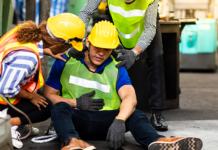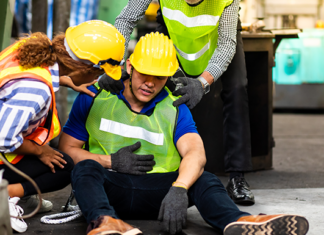We’re halfway through our series covering OSHA’s most frequently cited safety violations in the last year. Today we’ll discuss the fifth most frequently cited violation, scaffolding in construction. Violations of this standard are a mainstay on the list year after year.
OSHA has had a standard in place for scaffolding safety since 1971. It has been updated several times throughout the years. The rule spells out the safety standards that regulate the design, construction, and use of scaffolds in the construction industry. It explains fall protection systems and describes the training any employee using scaffolding should undergo before being permitted to use them. In 2022, OSHA issued 2,285 violations. Let’s review the most cited violations related to scaffolding:
- Scaffold Fall Protection: 644 violations – Each employee on a scaffold more than 10 feet above a lower level shall be protected from falling to that lower level.
- Supported Scaffold: 306 violations – Supported scaffold poles, legs, posts, frames, and uprights shall bear on base plates and mud sills or other adequate firm foundations.
- Scaffold Access: 277 violations – When scaffold platforms are more than 2 feet above or below a point of access, portable ladders, hook-on ladders, attachable ladders, stair towers (scaffold stairways/towers), stairway-type ladders (such as ladder stands), ramps, walkways, integral prefabricated scaffold access, or direct access from another scaffold, structure, personnel hoist, or similar surface shall be used. Cross braces shall not be used as a means of access.
- Scaffold Platform Construction: 267 violations – Each platform on all working levels of scaffolds shall be fully planked or decked between the front uprights and the guardrail supports.
- Scaffold Fall Protection: 152 violations – Guardrail systems installed to meet the requirements of this section shall comply with the following provisions (guardrail systems built in accordance with Appendix A to this subpart will be deemed to meet the requirements of paragraphs (g)(4)(vii), (viii) and (ix) of this section).
Common Scaffolding Hazards
Scaffolding safety measures and procedures are taken seriously by OSHA since falls from elevation are the main risks. Falls from elevation are the leading cause of workplace injuries and even deaths in the construction industry. The U.S. Bureau of Labor Statistics reports that over 62 percent of construction workers are exposed to heights when their center of gravity is more than five feet off the ground. Working at heights of any level increases a worker’s risk of injury from falling. A few of the most common scaffolding hazards include:
- Lack of fall protection equipment such as railings and personal fall protection systems.
- Improper safety measures when raising and dismantling scaffolding.
- Proximity to overhead power lines presenting a high risk of electrocution.
- Planks slipping or breaking.
- Workers struck by falling items from the scaffold, such as building materials, tools, and debris.
- Overloading or instability of the scaffold causing it to collapse.
Scaffolding Safety Tips
In 1995, OSHA revised its scaffold standards, and the U.S. Bureau of Statistics found that 25 percent of workers received no training on scaffold safety. Employers are responsible for ensuring compliance with OSHA’s regulations, and workers should be properly trained and familiarized with them. Without proper measures in place, scaffolding can be a hazard to the employees utilizing it and to others working nearby. Seven essential scaffolding safety tips to follow include the following:
- Designate a competent person capable of identifying existing and predictable hazards in the surroundings or working conditions that are unsanitary, hazardous, or dangerous to employees and who is authorized to take prompt corrective measures to eliminate them.
- Make sure workers are following the manufacturer’s instructions when constructing the scaffold. A competent person must supervise the building, moving, and dismantling of scaffolding, as well as inspect all scaffolds and all components before each work shift prior to use to ensure the scaffold is safe and undamaged and after each work shift when work is done.
- Always use fall protection while working on scaffolds. Make sure that guardrails are in place and secure. Workers should also wear personal protective equipment (PPE), including hard hats, harnesses, and lanyards when working at heights.
- Always follow the manufactures load capacity and never exceed the maximum load capacity of the scaffold. OSHA states that “each scaffold and scaffold component must support without failure its own weight and at least four times the maximum intended load applied or transmitted to it.” Additionally, distribute weight evenly and not overload one side of the scaffold.
- Ensure the scaffold is secure by tying, bracing, or something equivalent to these means. Scaffolds must also be securely fastened to the building structure to prevent movement or tipping.
- Maintain a safe work area by placing warning signs around the scaffold to alert workers and pedestrians of potential hazards. Keep the work area free of clutter and debris, and quickly clean up any spills that could cause slippery surfaces near the scaffold.
- Use proper access when the scaffold platforms are more than two feet above ground or below a point of access. Safe and secure access to the scaffold by using ladders or stairs should be used, not items like boxes or other unstable objects.
- Train workers to ensure they can identify the common scaffolding hazards and understand how to minimize them. Training should include sessions on the specific hazards, including falls, falling objects, and electrical concerns, as well as how to use the scaffold and handle materials properly. Untrained workers should never use scaffolds.
ICW Group’s Safety OnDemand learning management system contains a full suite of safety resources, training, webinars, and a comprehensive learning management system to assist you with scaffolding. Registration is free with a workers’ compensation policy. In addition, ICW Group offers a Fall Protection Program Wizard and a Fall Protection Program Audit to assist you with your Federal OSHA compliance efforts.
If you have any questions or need assistance developing your safety program, please contact ICW Group’s Risk Management Services, and we will be more than happy to assist you.

















